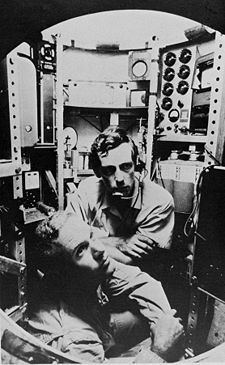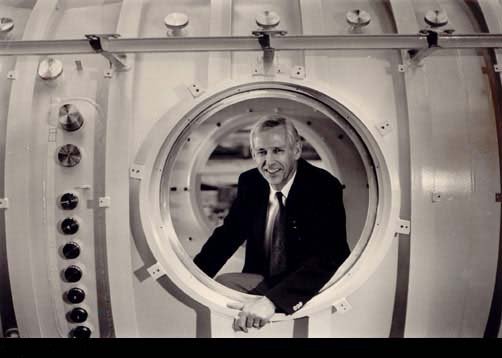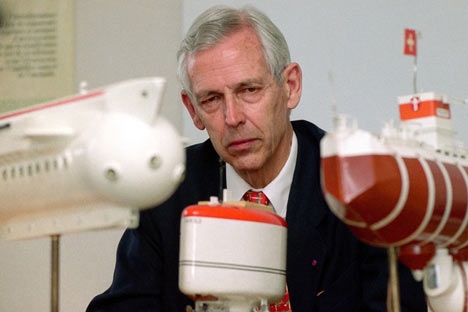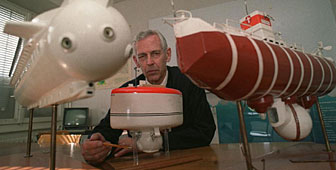
November 1, 2008

Swiss oceanologist Jacques Piccard, one of the 20th century’s last great adventurers, has died at the age of 86 at his home on Lake Geneva.
Credited with designing submarines that could withstand the planet’s most uninhabitable environments and one of two men to reach the deepest point in any ocean, Piccard died on Saturday, November 1, 2008.
In 1960, along with United States Navy Lieutenant Don Walsh, Piccard descended 10,916 metres secured inside the submarine Trieste, to the bottom of the Mariana Trench off the South Pacific island of Guam.
The craft took five hours to reach the murky bottom, where Piccard and Walsh encountered flat fish and other species, which at the time had been believed not to be able to survive at those depths.
But with 40 million tons of pressure on the submarine and a crack in one of the 19-centimetre thick windows, the hydronauts stayed barely 20 minutes before making an ascent of over three hours to safer waters.
Their feat has not been replicated.
Cryptid Observed
Piccard and Walsh had unique views of animals never seen again. One was the Challenger Deep Flatfish, which appeared to be a flat abyssal fish of the North Pacific Ocean, named after the Challenger Deep in the Mariana Trench. It was described as sole-like with two distinct eyes.
On January 23, 1960, the bathyscaphe Trieste, piloted by Jacques Piccard and Donald Walsh, reached a record depth of 35,800 feet (7 miles) in the Challenger Deep. As they touched down on the bottom, a flatfish with two distinct eyes swam away to avoid them.
It has never been seen again or caught.

Legendary family
Born in Brussels on July 28, 1922, Jacques Piccard was the son of physicist and adventurer Auguste Piccard, the first person to reach the stratosphere in a balloon.
He studied economics and international relations in Geneva but joined his father in building deep-sea submarines, known as bathyscaphes, after reaching then record depths of over 3,000 metres.
Piccard’s 1960 discovery of living organisms in at a depth of over 11,000 metres led to the prohibition of nuclear waste dumping in ocean trenches, one of Piccard’s most significant accomplishments.
Several years later, Piccard brought the adventure – albeit on a smaller scale – to the masses. During Expo 64 in Lausanne, Piccard’s 166-ton submarine Mesoskaph transported some 33,000 visitors to a depth of 60 metres in Lake Geneva.
In 1969, Piccard would spend a month drifting some 3,000 kilometres in the Gulf Stream at a depth of over 300 metres, studying the warm Atlantic currents.
He founded the Foundation for the Study and Protection of Seas and Lakes in the French-speaking town of Cully. He lived in the town of La Tour-de-Peilz, between Vevey and Montreux.
“There is still so much to do before I die,” he said on his 80th birthday, and would continue to design and supervise construction of his submarines for two more years. He made his last dive at the age of 82.

“Sense of curiosity”
“He passed on to me a sense of curiosity, a desire to mistrust dogmas and common assumptions, a belief in free-will, and confidence in the face of the unknown,” wrote his son, adventurer Bertrand Piccard, on his website on Saturday.
“His three children, Marie-Laure, Thierry and myself all owe him a certain vision of life, in which respect for others is the guiding principle, and dreams can be realized through perseverance.”
In 1999, the younger Piccard was the first to circumnavigate the globe in a balloon, and in 2011, will attempt to travel non-stop around the world in a solar aircraft.
On Saturday evening, the spokesman for Bertrand Piccard’s company, Solar Impulse, told swissinfo that funeral arrangements had not been arranged yet.

About Loren Coleman
Loren Coleman is one of the world’s leading cryptozoologists, some say “the” leading living cryptozoologist. Certainly, he is acknowledged as the current living American researcher and writer who has most popularized cryptozoology in the late 20th and early 21st centuries.
Starting his fieldwork and investigations in 1960, after traveling and trekking extensively in pursuit of cryptozoological mysteries, Coleman began writing to share his experiences in 1969. An honorary member of Ivan T. Sanderson’s Society for the Investigation of the Unexplained in the 1970s, Coleman has been bestowed with similar honorary memberships of the North Idaho College Cryptozoology Club in 1983, and in subsequent years, that of the British Columbia Scientific Cryptozoology Club, CryptoSafari International, and other international organizations. He was also a Life Member and Benefactor of the International Society of Cryptozoology (now-defunct).
Loren Coleman’s daily blog, as a member of the Cryptomundo Team, served as an ongoing avenue of communication for the ever-growing body of cryptozoo news from 2005 through 2013. He returned as an infrequent contributor beginning Halloween week of 2015.
Coleman is the founder in 2003, and current director of the International Cryptozoology Museum in Portland, Maine.
Filed under Breaking News, Cryptotourism, CryptoZoo News, Cryptozoologists, Cryptozoology, New Species, Obituaries, Sea Serpents